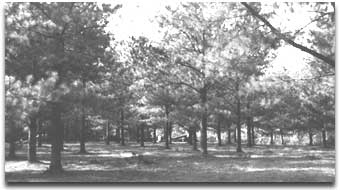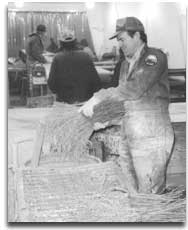 The
arrival of John S. Ayton State Tree Nursery in Preston -- nursery manager Richard Garrett and his staff are in full swing! All are hard at work, preparing the 5 million-plus seedlings that will be shipped to tree planters across Maryland and Delaware. This year alone, homeowners, farmers, foresters, wildlife managers and volunteers will plant a total of 38 different species of trees and shrubs raised at the nursery. While it is believed Confucius said, “the best time to plant a tree was 20 years ago,” the folks at the state tree nursery have adopted another: There is no time like the present.
The
arrival of John S. Ayton State Tree Nursery in Preston -- nursery manager Richard Garrett and his staff are in full swing! All are hard at work, preparing the 5 million-plus seedlings that will be shipped to tree planters across Maryland and Delaware. This year alone, homeowners, farmers, foresters, wildlife managers and volunteers will plant a total of 38 different species of trees and shrubs raised at the nursery. While it is believed Confucius said, “the best time to plant a tree was 20 years ago,” the folks at the state tree nursery have adopted another: There is no time like the present.
The 300-acre John S. Ayton Nursery was built in 1995, when state officials decided to move the state nursery from its site at Buckingham near Baltimore-Washington International Airport to a new location in rural Caroline County. The state of the art facility is named for John Ayton, former nursery supervisor at Buckingham, who was instrumental in the new nursery’s design and construction, from buildings to grounds and operations. John began his career with DNR’s Forest Service in 1961 and retired in 1996, one year after the new nursery’s completion.
The new nursery started shipping seedlings in its first year of operation, but the 2.3 million trees produced did not meet the staff’s expectations. One year later, the nursery produced in excess of 3 million seedlings, which was considered a marked improvement. “Every year we learn and adapt,” Richard says. By the spring of 2002, more than 7 million young trees were packaged and shipped.
From Seed to Seedling
A seedling’s life begins in the fall, when seeds are purchased and collected
from trees in state orchards at the nursery. Volunteers, students, homeowners, community groups and DNR personnel collect thousands of pounds of walnuts. The seeds are collected from parent trees displaying good growth and form and are
then hauled to the nursery for further processing and planting in nursery beds.
The “lifting” of seedlings begins in December. Hardwood species are the first seedlings removed from the beds and brought into the facility’s coolers. The two massive coolers, which are located in the shipping building, can each hold up to 4 million seedlings. Five staff and a contract crew then begin to prepare the hardwoods for shipping. This process includes dipping the seedlings’ roots in a clay mixture to retain moisture before the final packaging.

A loblolly pine orchard on the nursery's expansive grounds.
Throughout February, March and April, seedlings are continually dug up and readied for shipping. Loblolly pine is the predominant species in the 50 acres of the state’s orchards, and the contract crew processes up to 300,000 loblolly seedlings each day. The empty seedbeds are then tilled, and from late April into June the beds are reseeded.
Specialized machinery is needed to enable the year-round operation to meet its ever-growing demand for seedlings. The egedal plant lifter, widely used in Europe, allows three people to lift and remove the same amount of seedlings that previously required 12 people. Machinery for planting, extracting and cleaning seeds, removing walnut husks, and digging seedlings are all critical to the nursery’s operations. In the shipping building, workers gather around two conveyor belts that are used to grade and count seedlings. As would be expected, tractors and forklifts are also common sights around the nursery. Work continues unabated through the summer as the staff irrigates, fertilizes and weeds the seedbeds.
Conservation purposes
Seedlings are grown for many purposes, chief among them to provide wildlife
habitat, watershed and soil protection, windbreaks, sound barriers, forest
products, and stream buffer stabilization. One legislative initiative, the
federal Conservation Reserve Enhancement Program (CREP), encourages Maryland
landowners to plant seedlings along waterways for the creation of forest buffers
by paying them bonus land rental rates and reimbursing their installation costs.
Those with croplands or marginal pastureland by streams or on erodible soils
within 1,000 feet of water are eligible for the program. Bald cypress, swamp
chestnut oak, silky dogwood, and red osier dogwood are just four of several
species available at the nursery for planting in moist soils and along stream
banks.
Deciduous trees such as hazelnut, black cherry, flowering dogwood, chestnut
oak, paw paw, and American plum are valuable wildlife food sources.
Conifers such as white pines, Norway and white spruce are used for visual
and audio screens and windbreaks.
 Seedlings for Arbor Day
Seedlings for Arbor Day
One of the busiest times of the year at the John S. Ayton State Tree Nursery is early spring, when Marylanders gear up to celebrate both the official end of the winter and the coming of Arbor Day, traditionally the first Wednesday of April. Its founder, Julius Sterling Morton, said: “Arbor Day... is not like other
holidays. Each of those reposes on the past, while Arbor Day proposes for the
future. The cultivation of flowers and trees is the cultivation of the good, the
beautiful, and the ennobling in man.”
You can access a copy of the Nursery catalog, as well as find out what species are currently available, their conservation benefits, and how to order, by checking out the nursery’s website here. Seedlings can also be ordered by calling 1-800-TREES-MD.
By Richard Garrett and Dave Reinecke
Dave Reinecke... now retired,served as the Forest Service’s Eastern Region Information and Education Specialist. A native Marylander, he graduated from Allegany Community College with a degree in Forest Technology in 1976 and joined the DNR Forest Service in 1979. Dave provided the photos for this article.
Richard Garrett... became the John S. Ayton State Tree Nursery Manager in 1996. He grew up on his family’s farm near Port Royal, Virginia and graduated from Virginia Tech University in 1984 with a degree in Forestry. Richard has been with the DNR Forest Service since 1984.
Note: This article originally appeared in The Maryland Natural
Resource, Spring 2003. It was up-dated in September 2008.